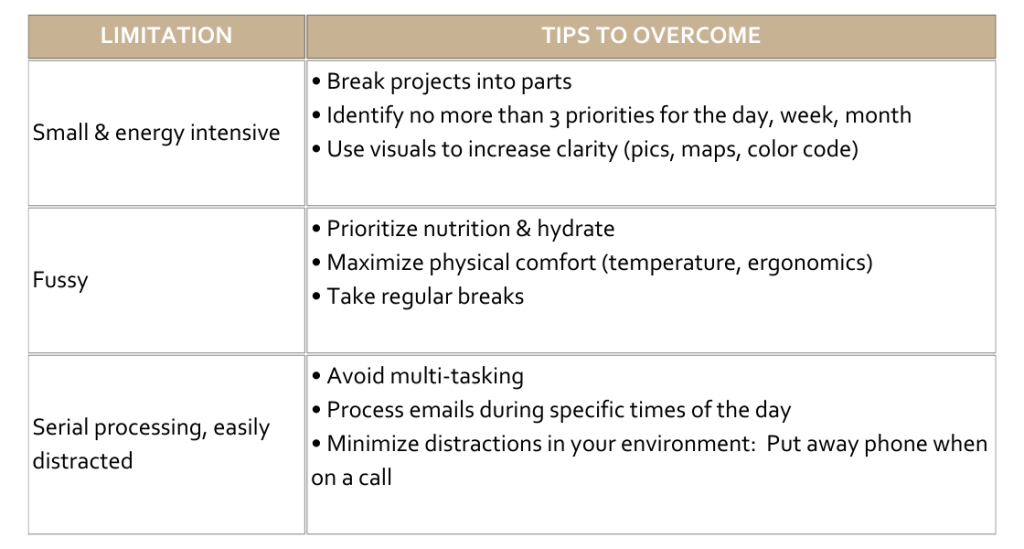Do you feel overwhelmed? Need to be more organized? Can’t seem to focus? You are not alone. We often think about this as an opportunity to focus on time management skills. Looking at it from a “brain-friendly” way, I challenge you to think about it as a focus on attention management skills.
How do we optimize our time and energy to make the most of our day? It’s about knowing your energy levels- how to best utilize it and when.
In the next two blogs, I explore how our brain is wired to do this: By focusing and accessing our prefrontal cortex (PFC) and nonconscious processing so we can be more creative, think strategically, solve problems, and learn new things.
There are 2 strategies to optimize your focus and capacity to make the most of you and your day:
Strategy #1: Work with limitation of PFC (maximize time – correction …attention)
Strategy #2: Create a healthy mind platter (maximize energy)
In part 1, let’s take a look at Strategy #1 and tips you can do to enhance your attention management:
Strategy 1: Work with limitations of PFC
The PCF is a small but resource hungry part of our brain with limited resource. It can only do one task at a time and gets distracted easily. It also needs the right chemical balance of dopamine and norepinephrine (noradrenaline) to function at its peak (so it’s fussy). If the levels are less, we experience tiredness or boredom. If it’s too much, we get stressed out. If it’s just right – we attain peak performance. The PFC is referred to as the “Goldilocks of the brain” (Arnsten 2007).
Here are some tips to get your peak performance based on the limitations:
IF-THEN Plan is an effective tool to keep you “in-check” and build good habits that respect the PCF limitations. Basically, you fill in the blank: IF I am tempted to multi-task, THEN I chose one thing and set a 30-minute timer. IF I feel overwhelmed by an assignment/project, THEN I will break it down into chunks.

Prioritize Task – Think of your tasks with having different degrees of cognitive difficulty. Some tasks may require minimal thinking and can be done in auto-pilot while others require your undivided attention.
Think of your tasks in-terms of degree of difficulty:
Level 1 – Quick & Easy: Does not require much thinking or effort and use of PFC is minimal. Example: Responding to email request for info that you can easily bring to mind while watching Netflix. Current projects fall into this easy category because information about them is stored in our short-term memory and is easily accessible.
Level 2 – Medium: Next degree. Example: Writing an email to a peer summarizing key points in a meeting they missed. You took notes about points relevant to you, but now you have to think about what is relevant to your peer. You need to think about the recent past and engage your working memory and navigate a level of ambiguity.
Level 3 – Hard: These tasks deplete our cognitive resources the fastest. Any activities that you may need to do from a blank page such as creating, conceptualizing, abstract thinking or high degree of uncertainty. Example: Create a strategy plan or writing this blog (ha-ha)!
Knowing when your energy is at the fullest and scheduling more critical thinking tasks (level 3) during those times will help maximize your performance (i.e. cognitive prime time).
Evaluate your day to reach your peak performance. Try It!:
- Use the template below to record your daily work activities.
- Identify when you have your peak performance: Some of us are early birds and others night owls. (I am an early bird. I function best in the AM).
- Use the same template to move your tasks around based on peak performance and degrees of difficulty.
Example: Part of My Day prior to Evaluation:

Post Evaluation

